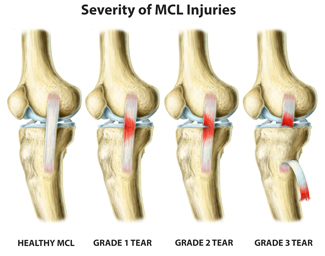What is the MCL?
The Medial Collateral Ligament (MCL) is located on the inner side of the knee, it connects your femur (thigh bone) to your tibia (shin bone) and helps provide stability to the knee by preventing widening of the inside of the joint. An MCL injury usually occurs when the knee is hit on the outside causing it to buckle in, which stretches out the MCL and can tear it.
Types of MCL Injuries 
An MCL injury is graded on a scale of I to III determined by the severity of symptoms.
Grade I MCL Tear
This is a partial tear of the MCL and symptoms include tenderness on the inside of the knee. Usually these take about two weeks to heal.
Grade II MCL Tear
This is also a partial tear but more severe than Grade I. There is definite tenderness on the outside of the knee and swelling may be visible where the ligament is located. Three to four weeks or more may be necessary to heal.
Grade III MCL Tear
This is a complete tear of the ligament. Symptoms include pain, swelling, difficulty bending the knee, and instability. It is possible for the knee to just give out with a complete MCL tear. For grade III tears, a knee brace can be utilized to limit mobility and may take ten to twelve weeks to heal.
[divider height=”1″ width=”250px” bg_color=”#34ceda” margin_top=”20″ margin_bottom=”20″ alignment=”center” display_icon=”off” /]
In need of MCL Injury Rehabilitation? Schedule an Appointment Today!
If you have any questions, or want a consultation with a professional, feel free to call, or schedule an appointment online at any of our Bergen County or Passaic County offices in New Jersey. Choose from Glen Rock, Franklin Lakes, Fair Lawn, Ho-ho-kus/Ridgewood, and/or Clifton – we make it possible for you to visit any of our offices at your convenience.
[divider height=”1″ width=”250px” bg_color=”#34ceda” margin_top=”20″ margin_bottom=”20″ alignment=”center” display_icon=”off” /]
MCL Injury Recovery
Protocol for MCL recovery can be broken down into IV phases, each with standards that have to be met before progressing on to the next.
Phase I
In this phase, the main goal is to reduce pain and inflammation. If in a brace and using crutches, before moving on to phase II you need to be able to painlessly walk normally.
Phase II
Strengthening exercises are introduced and you want to accomplish full knee range of motion (ROM) with no pain. Before moving onto phase III, there has to be little to no pain or swelling and you must be able to walking painlessly and at varying speeds.
Phase III
More advanced strengthening exercises are introduced and the goal is to be able to do weight bearing exercises pain free. To move on to IV, you must have little to no swelling and have no pain unless the movements are advanced. Some keep the brace on only while exercising.
Phase IV
The goal of this phase is to restore you back to normal life. If an athlete, this phase prepares you to go back to sport. More advanced strengthening exercise with the introduction of single leg weight bearing exercises.
For an MCL injury, usually one to two weeks is enough per phase but the actual length is determined by how long it takes you to reach the goal for that phase.
[footer title=”Do you, or someone you know need MCL Injury rehabilitation? We can help you with a simple consultation.”]

